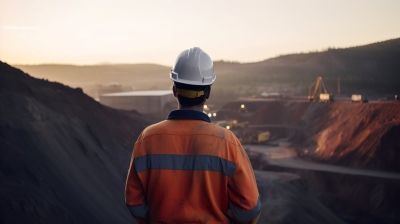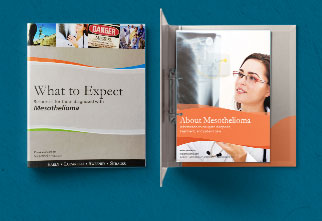Asbestos Miners & Mesothelioma
Asbestos exposure during mining occurs when workers disturb asbestos-containing rocks, releasing harmful fibers into the air. Miners experience an increase in asbestos-related diseases, including asbestosis, lung cancer and mesothelioma, due to prolonged inhalation of these fibers. The health risks of asbestos in mining can even extend to workers’ families through secondhand exposure.
Affected miners and their families may be eligible for mesothelioma compensation. An experienced attorney can help you explore your options.
Exposure to Asbestos in Mining

Miners are significantly affected by asbestos exposure due to the nature of their work. Small, enclosed spaces without ventilation, like the narrow tunnels of mines, increase the amount of hazardous fibers in the air. Frequent asbestos exposure over a long period of time, as you might see in asbestos miners who work every day for 10 or 15 years, also increases the risk of developing asbestos-related diseases like mesothelioma.
The Mine Safety and Health Administration (MSHA) has steadily dropped its recommended exposure limits for mining asbestos. While there is no safe level of asbestos exposure, the current 8-hour limit is 0.1 fibers per cubic centimeter (f/cc) or fibers per milliliter (f/mL).1
Still, a 2021 analysis that estimated exposure to asbestos in mine workers from 1961–1975 found that they were exposed to anywhere from 3 to 37 f/mL. In 1974, the MSHA limit was 5 f/mL, indicating that miners were exposed to high levels of asbestos even by the standards of the day. Workers involved in drilling, crushing and fiber separation were exposed to the highest levels.2
How Are Miners Exposed to Asbestos?
Asbestos is a natural mineral that develops along with other minerals within the earth. This means it can be found in asbestos mines and other types of mines, including coal, talc, vermiculite and taconite. These minerals are typically extracted from rock by drilling and then crushed into powder, releasing large amounts of dust and fibers into the air to potentially be inhaled.
Mining Asbestos
Asbestos mining in the U.S. began in the late 1800s and peaked in the mid-1970s. As the link between health risks, asbestos and miners became more well-known and strict safety regulations were introduced, production slowed.
The King City Asbestos Company mine in California closed in 2002, marking the end of U.S. asbestos production. However, asbestos statistics show that anyone who worked with this substance, as well as their families, could still be at risk of developing mesothelioma. Asbestos mining also continues in other countries, putting overseas contractors at risk.
Coal Mining
Coal miners face day-to-day dangers as well as long-term health risks. One of the most common is “black lung,” which is caused by inhaling coal fibers. However, asbestos can also be present in coal mines, occurring in the coal seams and surrounding rock formations. Coal miners can also be exposed to asbestos in the heavy machinery used in mines.
A report from MSHA found that 15% of non-asbestos mines, including coal mines, exposed workers to asbestos levels above the limit of 0.1 f/mL.3
Talc Mines
Talc is a soft mineral used in various products. Talc in makeup and baby powder are some of the most common uses. What many people don’t know is that asbestos may also be present in talc mines and in talc products.
Several recent cases, including the Johnson & Johnson asbestos lawsuits, have highlighted the potential risks of talc for consumers. The co-occurrence of talc and asbestos in mines also poses a danger for miners.
Vermiculite Mines
Vermiculite is a mineral that’s used in construction and insulation and sometimes develops alongside asbestos. Libby, Montana, is one of the most well-known sites of asbestos diseases linked to mine workers. W.R. Grace operated an asbestos-contaminated vermiculite mine in Libby that has sickened thousands of the town’s residents. The Environmental Protection Agency (EPA) declared the town a Superfund cleanup site in 2002. The EPA has decontaminated most of the town, but Libby’s residents and miners remain at risk of developing mesothelioma.
Taconite Mines
Taconite is a low-grade iron ore that’s often mined for steel production. However, taconite mining can disturb asbestos-like fibers, posing health risks to miners. In Minnesota's Mesabi Iron Range, miners have experienced higher rates of mesothelioma than the general population.4 This case highlights the fact that it isn’t just asbestos miners who are at risk of exposure and mesothelioma.
Asbestos Products Used by Miners
Asbestos exposure in mining doesn’t just occur from minerals that are being mined. Due to its heat resistance and durability, asbestos was widely used in equipment, construction materials, packing materials and even protective clothing.
Miners could encounter any of the following asbestos products on the job:
- Brake linings
- Brakes
- Cement
- Clutches
- Fire blankets
- Gaskets
- Gloves
- Hoist machines
- Masks
- Pipes
- Pumps
- Shuttle cars
- Starters
- Valves
- Winches
- Wiring
Miners and Mesothelioma Risk
Asbestos is the main cause of mesothelioma, a cancer that can develop in the lungs or abdomen. Mesothelioma usually takes decades to develop, meaning that unsuspecting miners could have been exposed before the risks of asbestos were even known. In addition to asbestos miners, their families and members of the community could also be at risk.
Increased Risk for Miners
Miners face an increased risk of mesothelioma due to prolonged exposure to asbestos fibers in confined spaces, as well as a lack of safety measures in the past.
One publication from the CDC5 shows that as early as the 1970s, researchers were finding links between talc and asbestos miners and mesothelioma. Two more recent studies6,7 have reported excess deaths from mesothelioma among miners of chrysotile, one of the most common types of asbestos.
Secondary Asbestos Exposure
Secondary asbestos exposure occurs when miners inadvertently bring asbestos fibers home on their clothing, skin or hair, potentially exposing their families. This indirect contact can lead to severe health issues, including mesothelioma, decades later. While workplaces are now required to implement protections to prevent this, families could have been exposed during the peak of asbestos mining activities.
Environmental Asbestos Exposure
You didn’t need to be an asbestos miner to be exposed to asbestos fibers. The communities around these mines are also at risk through environmental exposure, as the example of Libby, Montana shows. A 2017 report showed excess cases of mesothelioma and asbestosis for both miners and residents in Libby.8 Even before that, studies established cases of mesothelioma in those who live close to asbestos mines but did not work in them.9
Mesothelioma Compensation for Asbestos Miners
Mesothelioma compensation can cover medical treatments, including surgeries and chemotherapy, lost wages, travel expenses, home care and pain and suffering. Families of miners may also receive compensation for wrongful death claims, ensuring financial stability and justice for their loved ones.
An experienced attorney can help you explore the following compensation options:
Asbestos Trust Funds
Asbestos trust funds provide compensation to miners harmed by asbestos exposure that was caused by companies that have gone bankrupt. The process for filing a claim is generally easier and faster than filing a lawsuit. Your lawyer will help you determine which trust funds may be applicable to your situation and guide you through the claims process.
Mesothelioma Lawsuits
Mesothelioma lawsuits help asbestos miners and their families seek compensation from the companies responsible for their exposure. Mesothelioma lawyers have experience in building strong cases, gathering evidence, representing miners in court and negotiating settlements.
Workers’ Compensation
Workers' compensation is a state insurance program that provides financial benefits to miners diagnosed with mesothelioma resulting from workplace exposure. It covers medical treatment costs, lost wages during treatment and disability benefits. A lawyer can help you determine if you qualify and navigate the application process.
How an Asbestos Lawyer Can Help
Asbestos exposure in mining was a fact of life for many workers in the 21st century. We believe those workers deserve compensation from asbestos companies, who knew about the health risks of their products and covered them up.
At Early, Lucarelli, Sweeney and Meisenkothen (ELSM), we have decades of experience with mesothelioma claims. We understand how to build a strong case and fight hard for you and your loved ones. In fact, we recently won a $1.6 million settlement for an asbestos miner.
Contact us for a free case evaluation to see if we can help you.
FAQs
Is asbestos still mined in the U.S.?
No, asbestos is no longer mined in the United States. The last asbestos mine, located in California, closed in 2002 due to increased awareness of the health risks associated with asbestos exposure, including mesothelioma and lung cancer. Strict regulations by the Environmental Protection Agency (EPA) and Occupational Safety and Health Administration (OSHA) have also contributed to the discontinuation of asbestos mining operations.
Request a Free Case Evaluation
Request a free case evaluation now if you or someone you love has been diagnosed with mesothelioma. The evaluation will cost you nothing. Our lawyers will travel to visit you at your convenience or conference call with you over the phone. We understand how difficult a time this is for you and will assist in any way that we can. You can also call us toll-free at 1-800-336-0086 at any time.
Sources
- Mine Safety and Health Administration, “Asbestos Exposure Limit,” Feb. 29, 2008. Available at https://www.federalregister.gov/documents/2008/02/29/E8-3828/asbestos-exposure-limit.
- T.G. Murphy, S. Bornstein, et al. Ann Work Expo Health. 2021 Jan; 65(1): 113–126. doi: 10.1093/annweh/wxaa092.
- Mine Safety and Health Administration, “Preliminary Regulatory Economic Analysis for Proposed Rule on Asbestos Exposure Limit,” July 2005. Available at https://arlweb.msha.gov/REGS/REA/05-14510(Asbestos).pdf
- C.S. Lambert, B.H. Alexander, et al. Occup Environ Med. 2016 Feb; 73(2): 103–109. doi: 10.1136/oemed-2015-103105.
- National Institute for Occupational Safety and Health, “Workplace Exposure to Asbestos,” Nov. 1980. Available at https://www.cdc.gov/niosh/docs/81-103/pdfs/81-103.pdf.
- D. Ferrante, D. Mirabelli, et al. Am J Ind Med. 2020 Feb;63(2):135–145. doi: 10.1002/ajim.23071.
- Joachim Schüz, PhD, Evgeny Kovalevskiy, et al. J. Nat. Cancer Inst. 2024 June;116(6):866–875. doi:10.1093/jnci/djad262.
- T.C. Larson, L. Williamson, et al. J Occup Environ Med. 2020 Jan; 62(1): e1–e6. doi: 10.1097/JOM.0000000000001760.
- M. Goldberg and D. Luce. Eur J Cancer Prev. 2009 Nov;18(6):489-503. doi: 10.1097/CEJ.0b013e32832f9bee.

Results
The jury awards and settlements we have received for our clients are among the highest in the country.
Occupation/Exposure
Mechanic
Age
66
State
WA
Results
~$102,200,000
Occupation/Exposure
Cosmetic Talc User
Age
75
State
AZ
Results
~$22,200,000
Occupation/Exposure
Talc Powder User
Age
59
State
UT
Results
~$20,000,000
Occupation/Exposure
Home Renovator
Age
75
State
RI
Results
~$15,100,000
Occupation/Exposure
Electrician
Age
62
State
NV
Results
~$13,800,000
Occupation/Exposure
Plumber
Age
49
State
CA
Results
~$13,500,000
Occupation/Exposure
Abatement Worker
Age
70
State
CT
Results
~$12,600,000
Occupation/Exposure
Pipefitter
Age
58
State
OH
Results
~$12,200,000
Occupation/Exposure
Pipefitter
Age
65
State
NV
Results
~$12,000,000
Occupation/Exposure
Navy Veteran
Age
48
State
CA
Results
~$11,700,000
Occupation/Exposure
Air Force Veteran
Age
84
State
KY
Results
~$11,700,000
Occupation/Exposure
Hairdresser
Age
66
State
MD
Results
~$11,500,000
